History of the Pawnee Tribe and its Correlation to Off The Rails.
“The Indians survived our open intention of wiping them out, and since the tide turned they have weathered our good intentions towards them, which can be much more deadly,” said by the ingenious John Steinbeck from his book America and Americans which explains that white colonists are the reason Native Americans were wiped out. This quote resonates with the idea that Native Americans aren’t meant to live long lives side by side with white pilgrims, but to be left to die and “wither” off. It’s important to understand the entirety of Native American history because they have survived through harsh times, due to colonist and Manifest Destiny. Even though Native Indians lived in United States before the colonist, it didn’t matter to them because of Manifest Destiny.
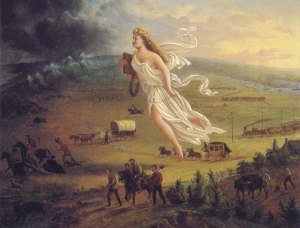
This painting is representing modernism in United States also known as, Manifest Destiny. Colonist expand through the west and change “primitive” world into a modern society. The angel in the middle is holding a book, telegraph wire, and changing the type of transportation from walking to horses and trains.
Manifest Destiny is an idea that all European settlers have the god given right to expand to the west and colonize indigenous people. In figure 1.1 illustrates manifest destiny through a remarkable painting by John Gast called “American Progress.” In this painting there is an angelic figure as the focal point moving west as a sign of progress, darkness disappears, wagons, and railroad. Whoever can’t be apart of the modernized society, as depicting in the painting are known as “primitive” individuals and die off such as agricultural workers and Indians.
Native Americans are the basis of American heritage and the foundation of America because they were the first ones residing in this country. They were the reason white colonists survived and their generosity lead to their own destruction. One Native tribe in particular stands out from the rest of the plains tribes and that is the Pawnee Tribe. In Randy Reinholz’s play, Off The Rails, is a love story of a Pawnee Indians named Momaday, and his white Irish wife named Caitlin, meanwhile being in a systematic boarding school and strict laws of the mid 1980’s.The correlation of the play and history of the Pawnee tribe will give a clear understanding of what happens throughout the play as well as clarity towards the characters.
Pawnee Indians originated from Nebraska also known as “Nebraska Territory” (Lacey 13). This particular location is very important for the Pawnee Indians because Nebraska is known to have the “grand view of the night skies.” The view of the night skies correlates with Pawnee Indians religious beliefs and their culture as a whole. Their god’s name is “Atius Tirawa” but commonly known as “Tirawa.” Their god’s name means “the expanse of the heavens” (Lacey 13). Pawnee Indians believed that their god lived in the heavens, but he was very lonely, therefore he came to the Earth and brought life as well as philosophical idea that “the thinking individual was the very essence of humanity, the connection with the Great Mind”(13). The “great mind” is known to be Tirawa because he believed that thoughts are made to understand the creations of the stars and why they are in certain directions in the sky.
Tirawa made semi cardinal stars in the sky and those stars made Earth. These semi cardinal starts are known as Evening Star (west star), Morning Star (east star), North Star and South Star.

In figure 1.2 it gives a simple explanation of where the semi cardinal direction are in bold letters. The reason why they are in semi cardinal directions, because Tirawa believes that it holds “the heavens up for all eternity” (Lacey 13). The first star is the Evening Star and it makes the first storm, thunder, wind, and music to create Earth. Unfortunately there weren’t any mountains or actual life on it, so there were more storms and earthquakes to develop mountains, animal life, and fauna. There was one type of life that was missing from the Earth and that’s was human life.
Human life was very mystical, because Tirawa told the Morning Star (boy) and Evening star (girl) to become humans, and procreate but they wouldn’t do it without falling in love and following the traditional Pawnee ways to make Evening Star Morning Star’s wife. These two stars took human formation, but didn’t’t love each other right away, because they fought tremendously. Finally, Morning Star fell in love with Evening Star, and he knew the only way to populate the Earth with humans is by marrying her despite the differences that they have.
Morning Star and Evening Star love story starts with obstacles. First they hated each other and then one of them fell in love with the other. Morning Star and Evening Star didn’t like one another until Morning Star realized his duty to Tirawa was to create humans on Earth. To be able to marry one another they have to exchange powers.”…Morning Star was coming for her, Evening Star put four fierce animals in the semi-cardinal directions. She put a wolf in the southeast and gave him power of clouds. In the southwest, Evening Star placed a wildcat, who gave power of the winds. She placed a mountain lion in the northwest, and gave him the power of lightning. In the northeast, Evening Star placed a bear with the power of thunder” states the levels of power and animals needed to figure out if Morning Star is worth it (Lacey 15).
The sun accompanied Morning Star and she believed that he was worth it. Sun helped Morning Star because he knew that Morning Star was meant for Evening Star; therfore, he aided Morning Star to court and marry Evening Star. They finally got married and had their first child which was a female who was carried from “the heavens to the earth by a whirlwind…” (Lacey 15). Their marriage and pro-creation led to the lives of many and finally became a Pawnee Tribe.
Pawnee have two types of houses: tipi and the earth lodge. The specific usage of each home help is important to understand because used for different reasons. The tipi is used specifically for “the hunting trail or warpath, or when they were away from their main camp for long periods of time…” (Lacey 29). Tipi’s are easy to dismantle and put together in any location, which gives them a proper amount of shelter anywhere they go by their horses or fat dogs.
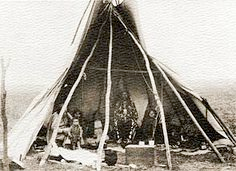
In Figure 1.3 shows the basic understanding of what a tipi is and how they make shelter for an entire family or a group of hunters. The frame of the tipi is constructed with long wooden poles, and hide skins (known to be waterproof). Tipis are known to be sustainable products in Pawnee culture which helped Pawnee Indians conserve energy, communicate, and plain for their next excavation.
The earth lodge is a permanent dwelling, and the circumference of the lodge is “about 40 feet in diameter.” The inspiration of the earth lodge comes from the night sky. They are following their God Tirawa, by building their home with a “heavenly dome” shape, so that it mimics the Earth outside.
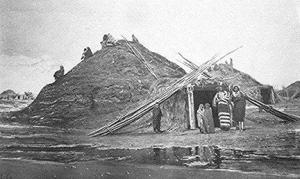
Figure 1.4 illustrates what an earth lodge looks like and the meticulous work that goes into building it. There is a group of Pawnee Indians outside of their earth lodge for guests to come and enjoy the religious saying of their chief. Etiquette in these lodges help with confusions such as going into a tipi without an invitation, or blocking two people from communicating properly. It’s important that everyone gets a long with one another, so that the tribe can have longevity. There are quite a number of rules in regards to visiting another lodge or tipi. “If the door flap is open, than this was a sign that the residents were receptive to visitors. If it was closed the visitors were to announce their presence and wait to be acknowledged and invited inside” explains proper etiquette on how to enter into a tipi by looking at the exterior of the home (Lacey 30). This will help with any type of miscommunication with one another, and lead to a more sustainable living. There is a sacred spot in the earth lodge called “wi-haru,” which is where “the wise words of those who have gone before us are resting” meanwhile men would sit down cross legged and women would sit on their heels while successfully being by the “wi-haru” (31). Lastly, there are sweat lodges that are similar to steam baths, where they take showers twice daily in addition to personal cleansing and purification rituals, which helped them live longer.
Tribal life consisted of hunting and gathering by both men and woman in the tribe. The Natives that hunted not only hunted buffalo, “they also hunted deer, antelope, and elk” (Lacey 31). The Pawnee believe that “buffalo was tangible proof that Tirawa cared for them. With the first of the bison, Tirawa provided the people with virtually all their needs” (31). Lacey states that the buffalo is much more than just food, it is used for multiple things such as clothing, therefore Tirawa blessed them profusely.
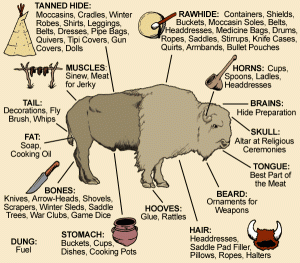
Figure 1.5 shows variety of ways buffalo is used for. It isn’t just food for Pawnee Indians, but clothing, skin is used to cover tipis, weapons, and most importantly food.
Marriages in the Pawnee tribe are significant for expanding the family and conserve their religious culture and values. In the Pawnee Tribe, marriages happen when boys and girls are of age. “The ages considered most auspicious for marriage were 15 for girls and 18 for boys, but with first marriages for both sexes there was often as much as a 15 year age difference between husband and wife” is a reasonable explanation of the age when children get married. The reason why there is a big age difference, because they would need someone who is experienced in hunting or help procreate (Lacey 57). They would get married in their religious Pawnee ways, like the Morning Star and Evening Star, meanwhile valuing that their relationship would be considered eternal.
Even though history has been hard for the Pawnee Natives, they still survived, even today. Francisco Vasquez de Coronado’s Spanish expedition in the 16th century allowed to meet Pawnee Indians. Coronado was sent to “America territories” by being forced by Henry the eighth’s decision to expand his reign (Lacey 65). These “conquistadores” traveled to different parts of the plains, and they finally met Pawnee Indians at the Republican River. Even though the Pawnee Natives didn’t understand what non-natives were doing in their land, they took advantage of their foreign utilities such as their horses, which helped Pawnee Indians hunt, and traveling easier. Due to raids, they were considered enemies to Coronado, but they didn’t have enough power till the land was sold “between Napoleon Bonaparte of France and President Thomas Jefferson of the United States which is known as Louisiana Purchase” (Lacey 66). Colonist thrived in the plains and ruined Pawnee life because it brought grave impact on them by depleting their food sources, and destroying their lands. Pawnee minds in structural European boarding schools suppressed their culture and language so that they would reflect typical white colonist’s behavior. Hence, Pawnee Indians would’ve started to believe that white colonist’s ways are the main way of living due to harassments, extreme punishments and diminishing their individuality. Colonists who made these structured schools solely wanted to breed out the Indians, so in the future they would be extinct.
History of the Pawnee correlates with Off The Rails play due to the historical emphasis on Pawnee history. It isn’t pin pointed out where the history is implicated but it is meant to be known and understood. As their god Atius Tirawa showed the emphasis of eternity, it is reflected in the play multiple times. Eternity is severely important to understand Momaday’s relationship with his wife Caitlin, for instance they got married in the Pawnee way, where marriage is considered eternal due to Tirawa’s belief that “heavens are held for all eternity.” In Act 1 Scene 2, when Caitlin is singing a love song to Momaday to express her love and he sing back in response, they start their short conversation about expressing their love for one another as shown in these few lines:
“Momaday: I love you. My wife.
“Caitlin: How much time do we have?”
“Momaday: An eternity together.” (Reinholz 11)
When Momaday said that they have an “eternity” together, he states it knowing his religious values that their love and marriage will live on forever. Hence, the ties of marriage are correlated with the idea of eternity, because he loves her is eternal. His words express his Pawnee cultural and their Pawnee style marriage where marriage is a forever bond physically and spiritually.
Atius Tirawa has stated that life is eternal. In order to understand what Momaday is saying in Act 1 Scene 10, about living on, is by understanding Atius Tirawa’s theme about living on even after death. When Momaday is talking to his grandfather about his marriage with Caitlin, he speaks a few lines that are pertinent to understanding what he means by “living on.”“Angelo can’t kill the baby, our child will live and so, A piece of me lives on… My faith in Caitlin will live on too” gives a clear explanation of why Momaday said “ live on” because life isn’t just meant to just live on earth, but to be live on forever (Reinholz 52). In the beginning of Pawnee life, it has been stated multiple times the importance of eternity and how life lives on forever. Hence, the basic understanding of Momaday’s marriage and his love for Caitlin will always be forever, not just for one lifetime.
Pawnee Indians and their history in correlation to Off the Rails not only explains the relevance of the history within the play through the written material as well as the show, but helps give a proper understanding why it matters. Pawnee Indians have lived in United States of America before any colonist. Through the eyes of history, students will be able to understand why one of the main character’s, Momaday, and his love for Caitlin being eternal. History isn’t meant to be repeated but to be learned, which Randy Reinholz had done through his brilliant work Off The Rails.
Works Cited
Lacey, Theresa. The Pawnee. Ed. Frank W. Porter. Philadelphia: Chelsea House
Publishers,1996. Print.
Steinbeck, John. America and Americans.Ed. Susan Shillinglaw and Jackson J. Benson.
Penguin. Voking: Classics, 2002. Print.
Figure 1.1 http://upload.wikimedia.org/wikipedia/commons/1/12/American_progress.JPG
Figure 1.2. http://upload.wikimedia.org/wikipedia/commons/thumb/1/1a/Brosen_windrose.svg/2000px-Brosen_windrose.svg.png
Figure 1.3 https://www.pinterest.com/johnsantuccio/paw-nee-indians/
Figure 1.4 http://windowontheprairie.com/wpcontent/uploads/2010/07/Pawnee_lodge.jpg
Figure 1.5 http://kadancesocial.weebly.com/uploads/2/5/6/9/25692258/7487264_orig.gif
Created by: Riffat Mustquima Rahman
Boarding Schools
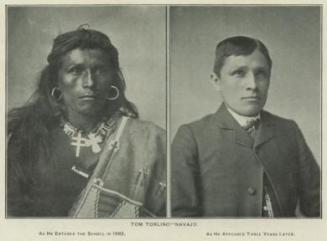
General Richard Henry Pratt founded the Carlisle Indian Industrial School in Carlisle, Pennsylvania on November 1, 1879. Pratt was a military man who was part of the Indian wars and then he moved onto to “teaching” Indians about how to live in mainstream society. The Carlisle school was militaristic and was a form of cultural genocide to Native people: the children were beaten or starved for speaking their Native languages, for practicing their Native cultures, or for just not assimilating properly in the eyes of the superintendent or teachers of the school. Pratt’s Carlisle school and his ideas were used as a model for many other Indian schools, including the United States Indian Boarding School in Genoa, Nebraska. He coined the phrase “kill the Indian, save the man” where he believed in the Americanization of Indians, by literally killing all aspects of being Indian to make an “American.” Indians were not considered to be American citizens until 1924; therefore they did not have any type of civil rights. The United Nations definition of genocide
“means any of the following acts committed with intent to destroy, in whole or in part, a national, ethnical, racial or religious group, as such: killing members of the group; causing serious bodily injury or mental harm to members of the group; deliberately inflicting on the group conditions of life calculated to bring about its physical destruction in whole or in part; imposing measures intended to prevent births within the group; forcibly transferring children of the group to another group.”
This definition can be applied to the federal Indian policy of the United States and how the federal government sought out to assimilate and terminate the indigenous peoples of America.
Indian Boarding School in Genoa, Nebraska
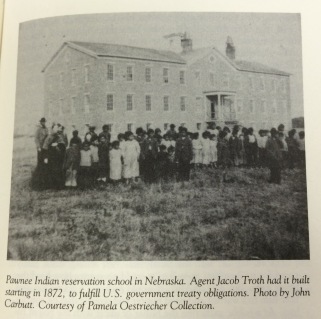
The Genoa Indian Industrial School was opened on February 20, 1884 and was modeled after the Carlisle Indian Industrial School in Pennsylvania. “All the schools, ideally, were to be located far from reservations to reduce contact between the children and their parents and Indian customs;” creating a sense of abandonment and loneliness for the children (Daddario 2). The first thing that was done to these children was they were stripped of their Native identities: their hair was cut short, they could not speak their Native languages, they were not allowed to perform any of their Native practices, and their clothes were changed. A universal belief among Natives is to grow their hair long because it is part of the soul, and the only time to cut the hair is if you are in mourning. The children were taught that their Native identities and cultures were worthless and they were forced into practicing the Christian religion and the “white” ways of life.
The federal government used their assimilation policy to force these children to go to these boarding schools. The federal Indian agents would go to reservations and forcefully take the children away from their homes against their own wills and against their parent’s wishes.
“Students were enrolled for three-year terms. The government paid for transportation to the school and return to the reservation after three years, but the students could not go home in the summer unless their parents came for them or paid for their transportation. Children could not leave the school during the school year without special permission from the Bureau of Indian Affairs, even if their parents requested it” (Daddario 2).
These schools were purposelessly placed far away from reservations, in order to disconnect the children from their families and their cultures.The problem here is that many of the student’s families were poor and could not afford to pick up their children during summer because the schools were too far away.
The Genoa School was both academic and vocational: half the day was dedicated to education and the other half of the day was dedicated to vocational training. The boys were taught how to farm, while the girls were taught how to take care of a household. These vocational tasks were considered valuable to teach the children because the government favored the “white” ways over the Native ways. When the settlers first came to the United States they thought the land was wild and untamed, but really the Native people had their own ways of tending the wild and working with nature. The tasks for the students were supposed to help prepare them to farm or take care of households, but this is not believable when the girls are cooking meals for fifty or more other people; not the typical size of a family household. The students ended up performing more vocational tasks for production than actually being educated.
Federal Indian Policy
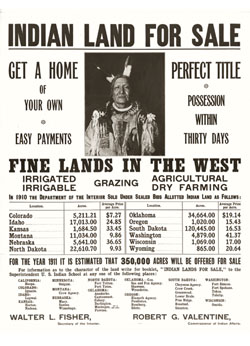
One of the ways to figure out the “Indian problem” the federal government came up with the assimilation and allotment policy from 1887-1939 in order to assimilate American Indians into mainstream society, by forcefully acculturating them. The idea was that the Indians could be assimilated, thus there would be no need for the federal government to fulfill their trust responsibility to tribes. The General Allotment Act or the Dawe’s Act broke up reservations by giving parcels of land to individual tribal members and then giving the “surplus” land to non-Natives; thus creating a checker board. This checker boarding of the reservation was part of assimilation because it broke up the tribal communities and disrupted tribal jurisdiction.
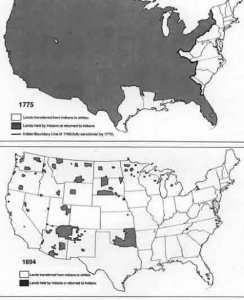
The federal government and tribes have a unique relationship: the tribes are domestic dependent nations and beneficiaries, while the federal government is the trustee to tribes. If the federal government were to assimilate all Indians and tribes, there would be no need for this trust relationship or reservations any longer. Indian tribes are looked at as a burden, instead of people who have suffered at the lies of the government; therefore the government owes tribes a great deal. The term “domestic dependent nations” means that tribes are considered sovereign nations, but the federal government limits the sovereignty of tribes and is responsible for the welfare of tribes at the same time. This is ironic because up until 1871 the federal government was forming
treaties with tribes. These treaties showed how the federal government viewed tribes as independent nations that they could contract with for land and resources in exchange for monetary compensation. By 1871 treaty making ended because the federal government obtained enough land and resources from tribes. The federal government did not fulfill their part of the treaties, and the Indian population had drastically decreased due to disease, war, and murder; therefore the federal government had enough power to do as they pleased with tribes.
Native Religions, Practices, and Languages Banned
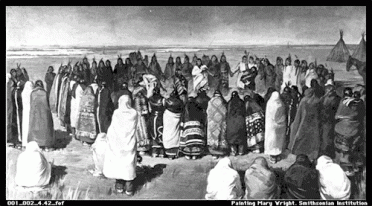
In the early 1880’s the federal government passed a law that banned Indian religion, culture, language, and prohibited Indians from leaving reservations. In Off the Rails Momaday’s sister, Isabel, states that “he should have left the traditional ways. It is dangerous to speak language or dance, how much more will they punish us if we pray or practice the old customs” (Reinholz 21). As part of the cultural genocide, the government banned all forms of Indian tradition and language, if anyone were to break this law they were punished. This can be paralleled with the Ghost Dance.
The beginning phases of the Ghost Dance began in 1870 Wodziwob, a Northern Paiute Indian from Nevada, “as a result of visionary experiences he had in the late 1860s” and told his people to round dance at night (Miller). By the 1880s a Paiute shaman, Wovoka, also had visionary experiences and the Ghost Dance spread to other tribes besides the Paiute. The American settlers and the government did not understand why the Indians were doing these round dances and it frightened and confused them; thus the Ghost Dance was made illegal. In the winter of 1890 Big Foot was traveling with the Lakota Sioux to the Pine Ridge Reservation when the 7th Calvary stopped them and made them camp at Wounded Knee Creek. The Calvary surrounded Big Foot’s camp with revolving machine guns even when he had a surrender flag flying above his tepee. A shot went off from the Calvary and they killed nearly three hundred Lakota’s from the camp, including Big Foot.
Works Cited
Daddario, Wilma A. “’They Get Milk Practically Every Day,’ The Genoa Indian
Industrial School, 1884-1934.” Nebraska State Historical Society. 27 Jan. 2010.
Web. 10 March 2015.
Figure 1.1. http://carlisleindian.dickinson.edu/images/tom-torlino-1882-and-1885
Figure 1.2. Blaine, Martha Royce. Pawnee Passage: 1870-1875. Norman: Oklahoma UP,
1990. Print.
Figure 1.3. http://americanindiantah.com/lesson_plans/FederalIndianPolicy.html
Figure 1.4 http://americanindiantah.com/history/nar_19thcenturyrelations.html
Figure 1.5. http://www.u-s-history.com/pages/h3775.html
Miller, Timothy. “The Ghost Dance.” World Religions and Spirituality Project. Virginia
Commonwealth University, Dec. 2011. Web. 10 March 2015.
Reinholz, Randy. Off the Rails. Native Voices.
Stanton, Gregory H. “What is Genocide.” Genocide Watch: The International Alliance to End
Genocide. Web. 10 March 2015.
Created by : Lora Paz